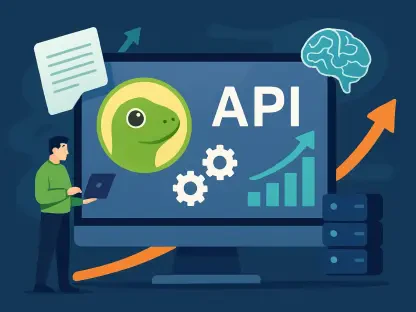In the rapidly evolving domain of artificial intelligence, the introduction of new technologies often signifies a shift in power, innovation, and capability. The launch of Moonshot AI’s Kimi K2, a large language model from a Chinese startup, exemplifies this phenomenon. Developed with the backing of Alibaba, Kimi K2 presents itself as an open-source model with agentic properties, offering an impressive blend of innovation and accessibility. The model features a staggering 1 trillion parameters, with 32 billion active at any given time, making it a formidable participant in the AI landscape. It has not only surpassed competitors like Claude Opus 4 in benchmarks but also performed better in various aspects than OpenAI’s GPT-4.1. Beyond its technical prowess, Kimi K2 provides significant cost advantages, charging only $0.15 per 1 million input tokens and $2.50 per 1 million output tokens, setting a new standard in cost-efficiency.
The Rise of Open-Source AI Models
Open-Source Dynamics: Innovation and Efficiency
The rise of open-source AI models has heralded a new era of collaboration and innovation, a trend exemplified by the development and launch of Kimi K2. By enabling global developers to access, modify, and enhance AI models, open-source frameworks have been instrumental in advancing technology at an unprecedented pace. Kimi K2 offers two open-source variants, Kimi-K2-Base and Kimi-K2-Instruct, catering to the needs of both researchers and developers. These models make it possible for a diverse group of technologists worldwide to contribute to, and benefit from, continuous improvements and adaptations. This burgeoning movement not only fosters creativity but also cultivates a collaborative environment that accelerates the adoption and integration of AI across different sectors. The open nature of Kimi K2 serves as a testament to the potential of open-source AI in spearheading technological advancements.
Global Influence and Geopolitical Shifts
China’s ascendancy in the AI sector, epitomized by Moonshot AI’s Kimi K2, reflects a broader global shift in technological leadership. This development challenges the established dominance of Western models, spotlighting a pivotal chapter in AI history. With its unique blend of technical prowess and accessibility, Kimi K2 positions China as a major player in the realm of artificial intelligence, marking a geopolitical shift that extends beyond mere technical achievement. The model’s open-source status ensures that it becomes quickly and widely embedded across a multitude of applications, reinforcing China’s influence on a global scale. As Kimi K2 continues to make waves in the AI field, it encourages Western companies to revisit their strategies, driving them to consider more open and collaborative innovation paths.
Strategic Implications for Western AI Companies
Shifting Paradigms and the Need for Adaptation
The debut of Kimi K2 underscores a growing necessity for Western AI companies to adapt to this shifting landscape. The AI industry is currently witnessing a dynamic transformation where Chinese models are rapidly ascending, challenging established norms with their open-source advantages and enhanced performance metrics. Western entities like OpenAI are now faced with the need to reassess their strategic approaches, particularly in terms of competitiveness and innovation. The contrast between closed-source traditional models and open-source newcomers like Kimi K2 highlights the demand for openness, flexibility, and cost-efficiency. These factors are pivotal in redefining the future trajectory of AI development, urging Western companies to recalibrate their methodologies and embrace open collaboration to maintain relevance and leadership in the AI race.
Integration and Future Prospects
The integration of Kimi K2 into various technological ecosystems marks a significant milestone in AI evolution, setting a new benchmark for future developments. Its release is not merely a technological triumph but a strategic maneuver that compels Western companies to reevaluate their own practices in fostering innovation and market competition. The model has significant implications, spanning both technical advancements and geopolitical dynamics, as it challenges Western supremacy in the AI sector. As Kimi K2’s influence continues to expand, it serves as a harbinger for future innovations, suggesting a paradigm where collaboration and openness become foundational pillars for growth. The ongoing evolution inspired by such models encourages all stakeholders to envision new horizons for AI, focusing on inclusive development and global synergy.
The Path Forward in AI Development
Redefining AI Collaboration and Competition
The introduction of Kimi K2 marks the advent of a new era in AI development, one characterized by collaborative efforts and competitive innovation. As this open-source model begins to permeate the fabric of various applications, it encourages an industry-wide reexamination of how collaboration and competition can coexist. The contrast drawn by Kimi K2’s performance and accessibility accentuates the importance of fostering an environment where shared knowledge propels forward-thinking solutions. This shift has also widened the dialogue surrounding intellectual property, ethics, and the democratization of AI technology. As companies worldwide grapple with these changing dynamics, embracing open-source principles may lead to unforeseen breakthroughs, positioning entities that adopt such strategies at the cutting edge of technological progress.
Balancing Technological and Geopolitical Equilibria
The release of Kimi K2 marks a significant turning point, impacting both technology and geopolitics. This model represents China’s strategic use of artificial intelligence to alter global power dynamics, challenging the traditional dominance of Western nations. For policymakers, researchers, and developers, this underscores the importance of developing integrated strategies that not only focus on technological advancements but also take into account geopolitical factors. As Kimi K2 gains momentum, it’s crucial to consider regulatory measures, international partnerships, and ethical standards to manage the intricate challenges posed by AI’s evolution. These components are vital in steering AI as a positive force, ensuring its development aligns with global good. Kimi K2 sparks crucial discussions about balancing innovation with ethical responsibility, paving the way for a sustainable and inclusive future in AI. In summary, Kimi K2 heralds a new era in AI, creating avenues for both collaboration and competition. By challenging existing norms, it has reshaped dialogues about AI’s development and its expansive implications, motivating global reevaluation of strategies.









